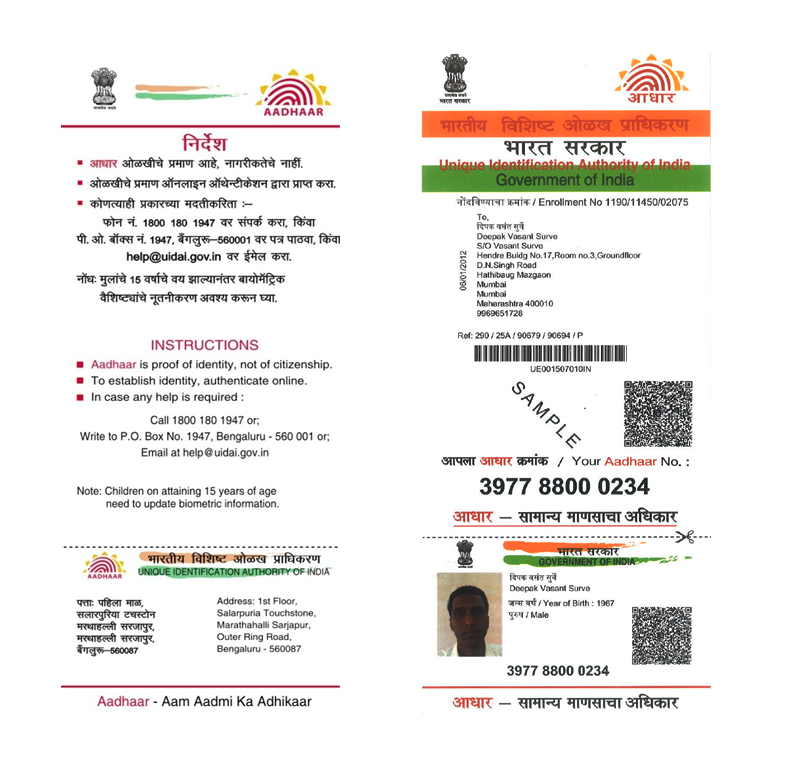Introduction:
In an era marked by technological advancements, Aadhar, India’s unique identification system, undergoes transformative updates in 2023. This comprehensive guide explores the intricacies of these changes, designed to fortify security, enhance the user experience, and align with evolving technology.

1. Enhanced Security Measures:
Security takes center stage with the introduction of advanced encryption algorithms and multi-layered authentication processes. These measures aim to safeguard personal information, ensuring the utmost privacy for Aadhar cardholders.
2. Virtual Aadhaar ID (VID):
A groundbreaking addition, Virtual Aadhar ID (VID), offers a temporary 16-digit random number for secure authentication. Users can share their VID instead of their actual Aadhar number, minimizing the risk of identity theft and providing an additional layer of confidentiality.
3. Biometric Locking/Unlocking:
Recognizing the importance of biometric data, the introduction of biometric locking and unlocking empowers users to control access to their biometric information. This feature adds a layer of security by allowing individuals to lock their biometrics when not in use.
4. Face Authentication:
To diversify authentication methods, face recognition technology joins the Aadhar repertoire. Users now have the option to use their facial features for authentication alongside fingerprint and iris scans, ensuring inclusivity and reliability.
5. Aadhar Authentication History:
The Aadhar Authentication History feature enhances transparency by allowing users to monitor when and where their Aadhaar was used for authentication. This newfound visibility fosters a sense of control and accountability over the use of personal identity information.
6. Offline Aadhaar QR Code:
Addressing connectivity challenges, an offline Aadhar QR code is introduced. This code, containing essential demographic information and a photograph, facilitates easy offline verification without the need for an internet connection.
7. Aadhaar for Children:
Streamlining the enrollment process for minors, UIDAI allows parents or guardians to provide their Aadhar details during the enrollment of children. This simplification ensures a smoother process for obtaining Aadhar for the younger demographic.
8. mAadhar App Updates:
The mAadhar mobile application undergoes significant updates, boasting a more intuitive interface, enhanced security features, and improved offline functionality. The app remains a convenient tool for accessing Aadhar-related services on the go.
9. Aadhar-PAN Linking:
In a move to enhance financial transparency, Aadhar-PAN linking becomes mandatory. This integration aims to create a unified financial database, making it easier for authorities to track and verify individuals’ financial transactions.
10. Aadhar in Government Services:
The government expands the use of Aadhaar in public services, from social welfare programs to public distribution systems. These updates strengthen the integration of Aadhaar across government initiatives, ensuring targeted and efficient delivery of services.
The Aadhaar updates of 2023 signify a significant leap towards a more secure, efficient, and user-friendly identification system. From robust security measures to innovative authentication methods, these changes reflect UIDAI’s commitment to adapting to the dynamic needs of the digital era. Whether you’re a seasoned Aadhaar user or considering enrollment, staying informed about these updates is paramount for maximizing the benefits of India’s unique identification system. Embrace the changes, secure your identity, and navigate the digital landscape with confidence in the Aadhaar 2023 era.
Aadhaar, the unique identification system in India, holds significant importance for individuals due to a variety of reasons, including:
1. Identity Verification:
- Universal Identification: Aadhaar provides a unique identity to every resident in India, eliminating the need for multiple identity proofs.
- Standardized Identification: It serves as a standardized proof of identity accepted across various sectors and services.
2. Government Subsidies and Services:
- Direct Benefit Transfer (DBT): Aadhaar is crucial for availing government subsidies and benefits directly transferred to the bank accounts of beneficiaries, ensuring transparency and efficiency.
- Social Welfare Programs: It is a key document for accessing social welfare schemes and services initiated by the government.
3. Financial Transactions:
- Bank Account Linkage: Aadhaar is linked to bank accounts, facilitating seamless financial transactions and enabling individuals to receive subsidies and payments directly into their accounts.
- PAN Linkage: Aadhaar-PAN linkage is mandatory for filing income tax returns and carrying out various financial transactions.
4. Mobile Number Linkage:
- Telecom Services: Aadhaar is often linked to mobile numbers, enhancing the security of telecom services and enabling quick verification.
5. Employment and Professional Activities:
- Employment Verification: Aadhar is used by employers for employee verification and for maintaining accurate employee records.
- Professional Services: It serves as a valid proof of identity for various professional services, including licensing and certifications.
6. Digital Identity and Authentication:
- Online Authentication: Aadhaar provides a digital identity that can be used for online authentication, ensuring secure access to various services and platforms.
- e-KYC (Know Your Customer): It simplifies the KYC process for financial institutions, telecom companies, and other service providers, reducing paperwork and time.
7. Healthcare Services:
- Health Insurance: Aadhaar is increasingly becoming important for availing health insurance services, streamlining the process of claim settlements and policy issuance.
8. Education:
- Educational Services: Aadhaar is used for student verification and availing of various educational services and scholarships.
9. Property Transactions:
- Property Registration: Aadhaar serves as an additional proof of identity in property transactions, providing an extra layer of authentication.
10. Address Verification:
- Address Proof: Aadhaar is accepted as a valid proof of address, simplifying the documentation process for various services.
11. Digital Services and Government Portals:
- Access to Portals: Aadhaar is often required for accessing government portals and digital services, ensuring secure and personalized interactions.
12. Emergency Situations:
- Emergency Identification: In emergency situations, having Aadhaar can expedite identification processes, especially when other documents may not be readily available.
In summary, Aadhar plays a pivotal role in simplifying and securing various aspects of an individual’s life, ranging from financial transactions to accessing government services. It serves as a comprehensive identification and authentication tool, contributing to the efficiency and transparency of public and private services in India.
